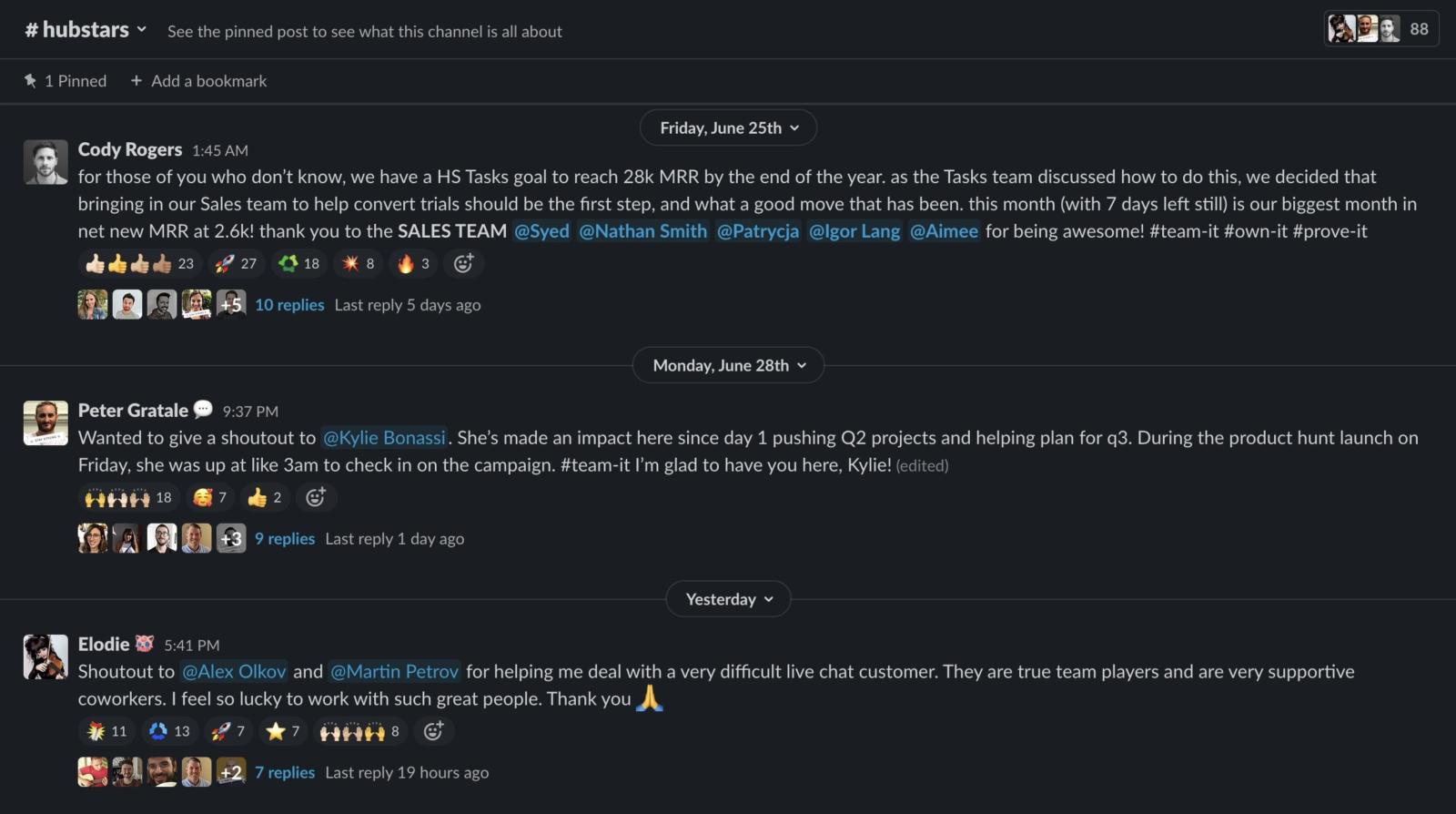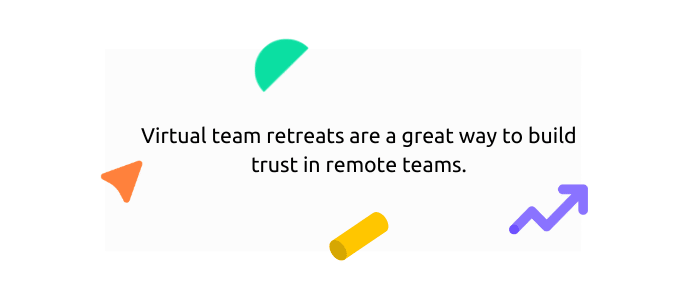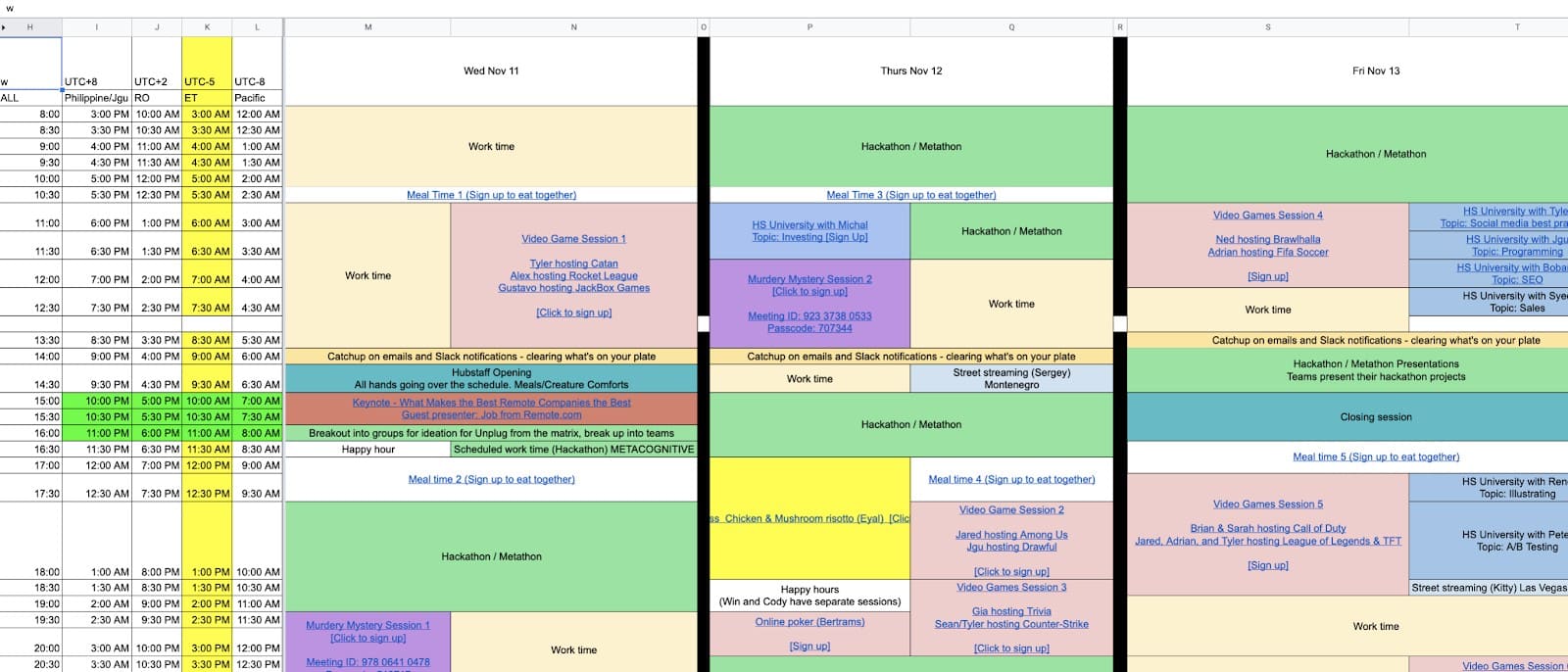It’s tough to admit that your team members don’t trust you — or each other. You care about your team and want them to succeed. How can you build trust?
If you’re managing a remote team, building trust is even harder. The lack of face-to-face interaction makes it more difficult to develop genuine relationships. You don’t have as much visibility to spot developing issues, and your team may feel isolated and unsupported.
Luckily, you can take action and fix trust issues in your team.
In this guide, we’re going to focus on strategies remote teams can use to build trust and improve collaboration. Most of the tactics we discuss will work for colocated teams, too.
But first, let’s look at why building trust in your virtual team is so important.
Subscribe to the Hubstaff blog
Why trust is important in virtual teams
Those that work in high-trust companies, on the other hand, report that they:
- Experience less stress – Working in a high-trust environment is a lot less stressful than one where team members doubt each other. Plus, if a manager has trust issues, they’re more likely to micromanage, causing more stress.
- Have more energy at work – Conflicts are a lot less common in high-trust teams. This means that team members won’t have to waste energy arguing. There are fewer emotional drains and it’s easier to be engaged and energetic in a trustworthy environment.
- Are more productive – When a manager trusts their team, they don’t slow team members down by second-guessing. This boosts the team’s productivity, and it’s a much more pleasant way to work.
- Take fewer sick days – Stress has a significant negative impact on people’s health. Since there’s less stress in high-trust teams, team members get sick less frequently.
- Are more satisfied with their lives – When a person feels that they can trust their manager and co-workers, they are more likely to be satisfied with their job. This, in turn, helps them have a better outlook on life.
All of these things are important. But if you’ve ever dealt with major trust issues at work, you already know that it’s important to build trust with your team.
Here’s how to do it.
How to build trust in virtual teams
When you first form a new team, trust seems easy. There’s a concept called swift trust that applies to groups of people who have to work together for the first time or for short-term projects.
At a very basic level, swift trust means that the people in your newly formed team automatically have some faith in each other because they need to rely on their peers to navigate a new situation. It’s almost like a honeymoon period for your team.
If you’re still in that phase, the strategies in this article will help you deepen and strengthen those bonds.
For teams that are past that phase, building trust is harder. It doesn’t happen overnight, but it’s well worth the time and effort to make your team happier and more productive.

Remember that repairing trust is a process. You might have to build your way back from a remote company culture that has a lot of issues, and it takes time to even get to a neutral position. Be patient. Your consistent effort will pay off.
Start here.
1. Be transparent
Transparency is key for building team trust. If you’re new to the concept, it can be tough. Work on it. It will get easier as you see that there are few risks and lots of benefits.

By being completely transparent with your team, you show that you trust them.
When you prove that you believe in your team, they trust you back. Plus, they’re better informed and more capable of making smart decisions that drive your business forward.
People deeply appreciate transparency. Your people want to know more about their company, co-workers, and the competition. They want the opportunity to get involved at every level, and they want to be respected enough that you ask for their opinion on major decisions.
This makes them feel like they’re part of the company, not just a tool someone else uses to get what they want.
However, it can be challenging to maintain transparency in a remote team.
When working remotely, you can’t see what your co-workers are doing. It takes extra effort to make work and ideas visible.

There’s also the issue of communication over multiple channels.
A lot of remote teams use tools like Zoom, Slack, and Google Drive all at the same time. This can make it tough to find information — have you ever dug through dozens of Slack channels trying to find a conversation you had a few days ago?
Still, if you want to build trust in your remote team, you need to ensure transparency at every level. Here’s how to do it:
- Prioritize public communication channels – It’s easy for information to get lost inside email chains. Phone calls and video chats are useful, but unless they’re recorded and shared, the takeaways never get past the people who were there. When discussing anything that’s important for the entire team, strive to use public channels like Slack.
- Share company goals and results – Talk openly about your team and business goals. Share company results and successes with the entire team. This openness shows team members you trust them, and it boosts their motivation as they get invested in the future.
- Create a shared team calendar – Another way to improve transparency is to create a shared team calendar. Add all your company events and meetings to this calendar so that everyone on the team knows what’s happening in the company at any time.
- Use project management software – Project management software improves transparency by showing the team every step in a workflow. Anyone can check the status of a project or task without bothering a teammate. Hubstaff Tasks even has automated Stand-ups and project roadmaps, which can help to further improve team transparency.
Each of these takes time and consistent effort. To help lead a transformation in your remote team, get our complete e-book. Then, keep reading for the next trust-building technique.
2. Use one-on-ones to build trust and support team members
As a manager, you should have one-on-one meetings with each team member at least once a month. These types of meetings are a great opportunity to build trust and develop stronger relationships.
Here’s how to maximize the impact of one-on-one meetings and connect with team members on a deeper level.
- Focus on helping team members achieve their goals – Your main goal during one-on-one meetings should be to learn how team members are doing and how you can help them achieve their goals. Ask questions like these.
- How have you been doing lately?
- Do you enjoy your work?
- Is there anything else you’d like to do?
- Is there anything I can help you with?
- Provide constructive feedback – When giving feedback to a team member, make sure it’s solution-oriented. Talk about how to improve instead of just telling them what they did wrong. While you’re at it, point out some of the things you’ve appreciated, too. It’s easier to trust your boss when you know they see the good work you do.
- Ask for feedback – Don’t just give feedback. Ask for it. Keep in mind that some team members might not be comfortable giving feedback publicly. That’s why you need to give your team a way to provide feedback anonymously. At Hubstaff, we use Officevibe. When you do get feedback, act on it. This will show team members that you care about their opinion, which is important for trust.
A one-on-one should be a safe place for your team to share ideas, talk about their career journey, and be honest with you.

If you’ve had trust issues so far, it will take time before your team feels safe enough to tell you the truth. Be patient and keep encouraging them to open up.
When someone does tell you the truth, it might not be what you want to hear. It’s crucial that you respond well. Never get defensive or argumentative when someone opens up to you. Learn to take criticism gracefully, even when it isn’t delivered in the most tactful way.
3. Manage conflicts, don’t avoid them
80% of remote team members have experienced workplace conflict. 65% of those conflicts were with fellow team members, while 19% were with a boss or manager.
According to remote teams, the three main sources of conflict in are:
- Work-related stress
- Lack of teamwork
- Rude behavior
Conflicts can also happen because of miscommunication or clashing work styles and personalities.
You might not be able to see them, but conflicts can and will happen in a remote team. Don’t ignore them. If you haven’t heard of any disagreements, it’s probably because you’re not paying close enough attention.

Ignoring these issues makes you look like you’re out of touch or you don’t care enough to get involved.
Managing conflicts effectively, on the other hand, will build trust and make team members feel more confident about you leading them.
Here’s how to do it:
- Act early – Small conflicts can grow into big problems if you don’t address them early. Work on resolving the issue as soon as possible so that your team doesn’t suffer any negative consequences.
- Listen to both sides – Stay objective when you step in to resolve a disagreement. Listen to each person’s story and get the details before you take any action.
- Resolve the conflict in private – Always try to resolve issues privately. You don’t want to embarrass team members in front of their peers, and it’s not wise to look like you took someone’s side in a personal argument. The better you are at solving problems discreetly, the more trustworthy your team will find you.
4. Hold everyone accountable
A lack of accountability is one of the top challenges for remote teams, according to a recent report.
It’s easy to understand why. Communication breakdowns make remote team members feel like they don’t know what to do with their day. Since there’s nobody around to watch them work, they might feel aimless. It’s easy to let tasks slip.

Even if it’s not intentional, a person who doesn’t keep up with their duties puts extra pressure on the rest of the team.
Those who keep up with their work may feel like you’re being unfair. Why should they work harder to make up for people who don’t do their jobs? They can’t see your interactions with other co-workers, so as far as they know, you’re ignoring the issue.
When you hold everyone accountable for their responsibilities, you’ll have an easier time building trust in your team.
Here are strategies you can use to increase your remote team’s accountability and trust:
- Clearly define team roles – Every team member should understand who does what within the team. There should be no question about their personal responsibilities, and they should know who to go to for help with a specific task. Clearly define team members’ roles and assign an owner to every project.
- Create a work from home policy – Design a work from home policy that outlines what kind of behavior is acceptable and how team members should communicate with each other. When everyone knows what you expect and the consequences of not meeting those expectations, you’ll improve your team’s accountability.
- Have regular check-ins – You can also keep your team accountable by implementing regular check-ins. Depending on the size of your team and the types of projects you work on, you can check in daily or weekly to learn about the status of a project and identify any roadblocks. Check-ins can be asynchronous so that you don’t interrupt work. Try automated Stand-ups to get your team accustomed to communicating more regularly.
5. Embrace mistakes
No matter how well you prepare, mistakes are bound to happen. Both you and your team members are human, and therefore prone to errors.
Embrace mistakes and get rid of the anxiety that something might go wrong. Make your attitude clear — things are going to happen, and you’ll solve the problem and move on.

Treating human error as a natural part of the process does two important things. First, it gives your team the freedom to try new things and take reasonable risks. Second, it makes it easier to trust your leadership because your team knows you’re ready to back them up.
If you’re naturally a perfectionist, this might be more of a challenge for you. Here’s how to conquer your gut reaction and deal with problems gracefully.
- Keep a cool head – Learning about an error, especially an expensive or avoidable one, can be frustrating. Fortunately, when you work remotely, you have plenty of space to take a breath and calm down. Never respond when you feel irritated. Pay attention to your hot buttons, too — you might tend to be less patient with specific types of mistakes.
- Avoid jumping to conclusions – Listen closely to everyone involved before you draw any conclusions. Apart from showing trust, this will also give you the information you need to prevent the same mistake from happening in the future. Keep in mind that you’ll have a natural bias towards the first thing you hear, so be mindful to listen fairly to everyone.
- Don’t take over – Stepping in and taking over the task to do it yourself is an even bigger mistake. Show that you trust your team by allowing them to fix the mistake themselves. You can point out a better way to move forward, but don’t take control away unless there’s no other option.
- Provide guidance – While you shouldn’t step in to fix other people’s mistakes, you can give advice and support. Make it clear that it’s okay to come to you for help. Support before you criticize and your team will be more likely to trust you.
6. Recognize team members’ achievements
When a team member feels like they don’t matter to you, it’s hard for them to trust. They worry that if they make even small mistakes, you’re just as likely to replace them as you are to help.

By recognizing when people do well, you prove that you do see people as important individuals.
For praise to be effective, it needs to be all of these things.
- Timely – Don’t wait to speak up. Sure, it’s nice to call out big achievements at your quarterly all-hands meeting, but make sure you recognize good work in the moment, too. Get in the habit of showing appreciation as soon as you notice an accomplishment.
- Specific – “Good job” is nice to hear, but not effective. What about this? “Excellent work finishing that extra project. It’s tough to take on extra work when you already have so much to do, and I’m proud of you for shipping this on time while you kept up with your other priorities.” This example is much more effective. When you’re specific about what someone did and why it matters, you’re more believable and make a bigger impact.
- Appropriate – The type and amount of recognition should be appropriate for the accomplishment. If you’re too enthusiastic about something minor, or if you don’t make a big enough deal about something major, your team will feel like you’re being false. Make sure you give achievements the attention they deserve without going overboard.
Create a culture of gratitude and recognition. Encourage your team to point out big wins so that appreciation comes from everywhere, not just from you.
At Hubstaff, we have a dedicated #hubstars Slack channel where team members can recognize each other’s achievements.

Recognition can be public or private. Consider the person. Some people love being praised in front of others, while others find it painful to be the center of attention.
Sometimes, it’s appropriate to go a step further. Big achievements deserve a reward.
- Gift cards – A digital gift card is a great way to say thanks. Make sure that the amount is appropriate, and choose a gift that your team member will actually use. Food delivery services, coffee shops, and online retailers are popular options.
- Bonuses – At Hubstaff, team members recognized in our #hubstars Slack channel receive a $50 bonus. Bonuses can be tied to specific goals, but surprise bonuses make a big impression, too. However you decide to offer financial rewards, make sure it’s fair for everyone on the team.
- Donations to a charity of their choice – Some team members might prefer donating to a charity they care about instead of getting something for themselves. Donations are especially effective if they’re tied to the company’s mission. For example, if you specialize in camping and outdoor sports, you might make a donation in a team member’s name to a conservation effort.
These suggestions are ways to back up your words with actions. That’s the foundation of integrity, and it’s vital when you’re working on trust within your organization.
7. Support employee wellbeing
Many of the tips we’ve shared so far have a common theme. When you treat your team like you care about them as people, they find it easier to trust that you have their best interests in mind.
That’s true of the advice in this section, too.

Take an interest in your team members’ health and wellness. A team that is both physically and mentally healthy performs better, takes fewer sick days, and ultimately makes more money for the business.
More importantly, though, a healthy team is more likely to be a happy team.
The CDC reports that mental health issues hurt performance, block communication, and cause other engagement issues that impact your business.
Employees with good health and mental hygiene find it easier to cope with stress. They can more easily trust each other — and trust you, too — because they’re not dealing with as many extra issues.
Create a wellness plan to support your team’s wellbeing. You’ll improve morale, increase job satisfaction, and reduce turnover.
Most importantly, you’ll create an environment where trust can flourish.
Whether it’s official or informal, your wellness plan should encourage your team to take care of themselves. Here are some ideas.
- Encourage people to take time off – Help team members achieve a better work-life balance by encouraging them to take more quality time off. Taking plenty of vacation time is linked to better performance at work. At Hubstaff, we encourage team members to take four weeks off every year.
- Be flexible – Instead of a fixed schedule, give your team the freedom to work when and where they prefer. With flexible work hours, team members can fit their careers around personal priorities. This can help to reduce stress and improve team members’ happiness.
- Provide a wellbeing budget – A lot of companies provide a wellbeing budget. Team members can use this budget to pay for a gym membership, spa treatments, or other healthy pursuits. Think of it as a flex spending account for wellness.
8. Organize a virtual team retreat
Hubstaff is 100% remote with team members around the world. Even though we try to get together in person at least once a year, it was simply impossible to do during the pandemic.
That’s why we organized a virtual team retreat. For three days, we bonded over cooking classes, gaming sessions, Murder Mystery parties, and more.
These types of events are a great way to build trust within your team.
Plus, they’re loads of fun. We enjoyed our first virtual retreat so much that we decided to do it at least once every year, along with our annual in-person retreat.

Want to organize a virtual retreat for your team? Here are the basics.
- Ask the team what they’d like to do – If you want to make sure your team will have fun during the retreat, involve them in the planning process. Ask them what kind of activities and events they’d like most.
- Create a list of events – Based on the team’s feedback and suggestions, create a list of events for the retreat. Ask team members to sign up for events they’d like to attend or host. If an event doesn’t get many signups, you can cut it from the schedule to make room for something more popular.
- Build a schedule – This is likely the most time-consuming part of organizing a virtual retreat. When building your event schedule, try to avoid having long stretches of time with no activities team members could join. It’s okay to leave some downtime, but it’s better to have multiple options for each major time slot.Here’s what Hubstaff’s virtual retreat schedule looked like:

- Get the right tools – To make sure your virtual retreat goes smoothly, you need to use the right tools. For our retreat, we set up a dedicated Slack channel to keep all our retreat-related communication in one place. We used Zoom for most events and Discord for our gaming sessions.
Zoom fatigue is real, so give your team members permission to take a break. Introverts especially need time to be alone and recharge. Strike a good balance between having lots of options to get together and plenty of space to step away.
Next steps
Ready to start improving trust in your virtual team? Here are three things you can do today:
- Set up a shared team calendar – Create a shared team calendar using Google Calendar to make sure everyone on your team knows about future events and meetings. You can find instructions on how to set one up here.
- Create a Slack channel for team recognition – Does your team use Slack? Create a #thankyou channel for praising team members when they do a great job.
- Ask your team if they’d be interested in a virtual retreat – Create a poll in Slack asking team members if they like the idea of having a virtual retreat team event. Let them suggest ideas of what they’d like to do during the retreat.
Building trust is a long process. Bookmark this post so you can come back to it when you’re ready for the next step.
This post was originally published in August 2016. It was updated in June 2021.
Subscribe to the Hubstaff blog for more posts like this
Most popular
Timekeeping Integrity: Strategies to Combat Timesheet Fraud
Just like the old saying goes, honesty really is the best policy — especially when it comes to filling out your timesheet. Times...
What Is Deep Work and How to Implement It
With smartphones, social media, and an increasingly distracted world, it’s increasingly rare for anyone to reach deep concentrat...
How to Build a Remote Team: A Comprehensive Guide
32.6 million Americans will work remotely by 2025. These numbers highlight how popular remote work opportunities are, but learning...
The MoSCoW Prioritization Method: Streamlining Project Management
Prioritization is the name of the game with the MoSCoW prioritization method, helping teams sort their work by importance to compl...





